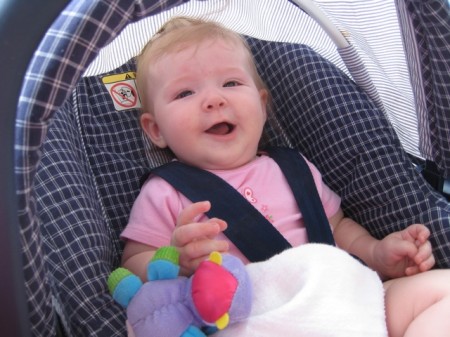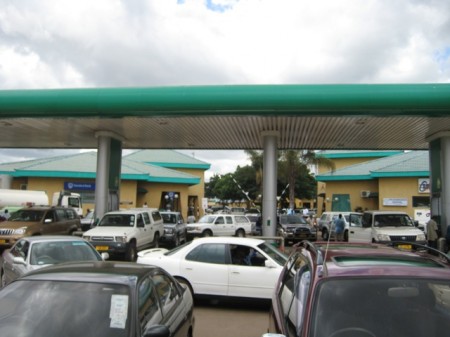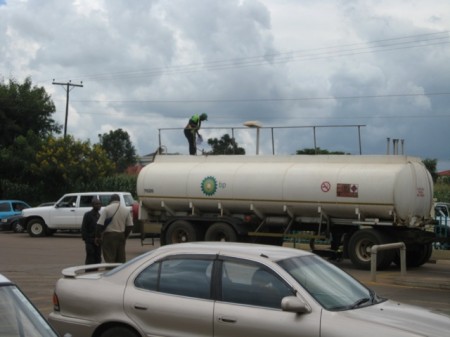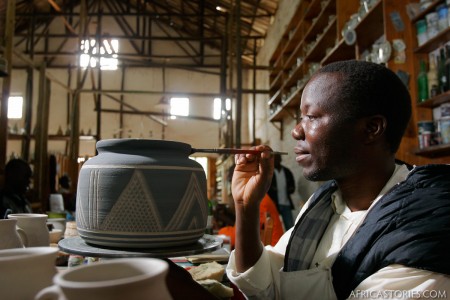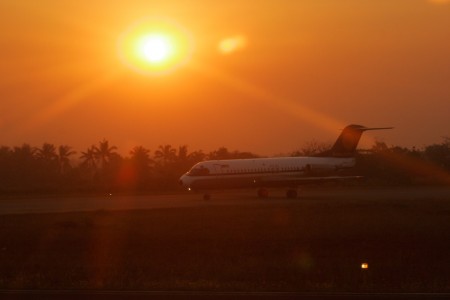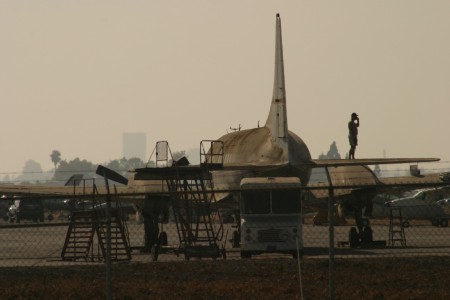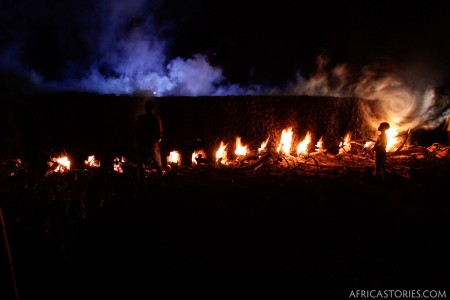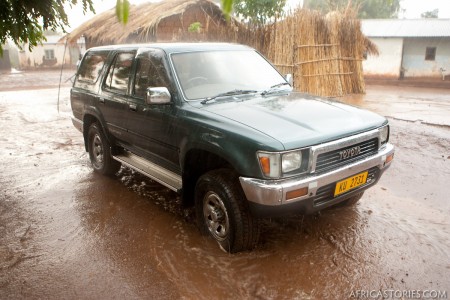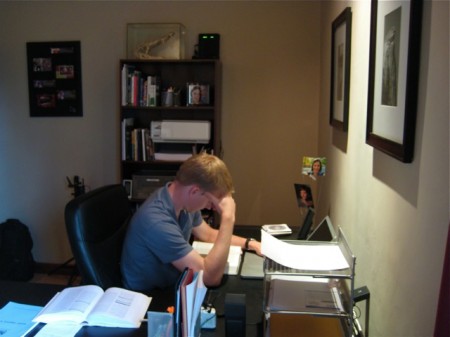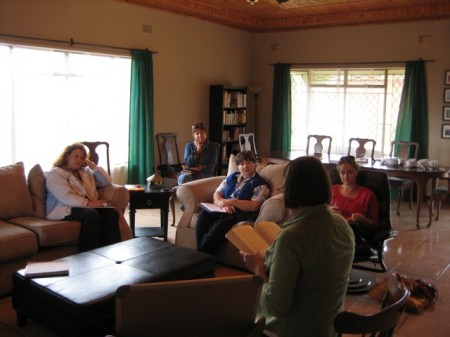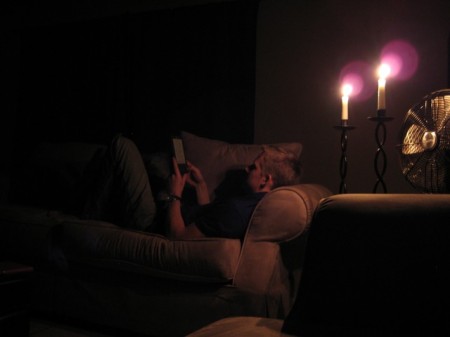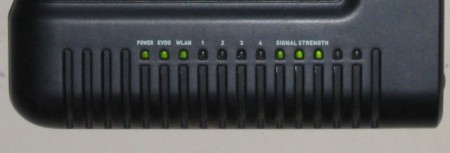Have Diesel, Will Travel
We’re going on vacation tomorrow! After our trip to Zomba last February, we decided that we need to get away for a few days once a year. There’s a lot of Malawi that we haven’t seen yet, so we’re headed north this time: a rain forest, a lakeshore stop, and the best national park in Malawi.
There was only one problem. Diesel. We’re in the middle of a fuel shortage again, and without diesel, we weren’t going anywhere. So this morning, Rachel woke up determined to get fuel.
The search started at 7:15am. No diesel anywhere along the main road through town. By 10:20, we’d gotten a tip that cars were starting to line up outside one of the gas stations on our side of town. Matt was busy studying to teach in Sunday School, so Rachel grabbed Abigail and they took off for the diesel adventure.
This cute little munchkin waited so patiently! We parked our car in line and sat in the shade in front of the BP convenience store, and she played for about an hour and a half, then fell asleep for about an hour.
Finally! The fuel truck pulls in. Unfortunately there were so many cars waiting to get fuel that the fuel truck couldn’t get through the parking lot! That took a bit of sorting out…
And we don’t have a picture of actually getting fuel, because Rachel and Abigail were rescued by our friend Kondi who traded us cars so that Abigail could finish her nap in her own bed. He waiting another hour and a half while the fuel truck unloaded and the cars in front of us filled up. What a friend!
So we’re off on vacation! We have a full tank of diesel and a full 30 liter jerry can as backup. We don’t know if we’ll find fuel up north, but we’re going to try and see how far we can get!
Dedza Pottery
An Infrequent Flyer’s Guide to Using Frequent Flyer Miles – Part 1
(Matt) Over the years, I’ve lost hundreds of thousands of frequent flyer miles. I imagine that if I could have somehow consolidated them, I could fly around the world… but they’re gone. I lost some because I didn’t get around to signing up for a membership card with Northwest or Swiss or some other “random” airline. I lost some because I didn’t have my card when I was at the airport. And most of them were lost because they expired before I did anything with them.
I think I knew all along that frequent flyer programs were designed for, um, frequent flyers. And the last several years, I’ve been more of a “take 1-2 really long flights each year” kind of flyer. Any guesses how many miles we fly from Lilongwe to Nairobi to London to Los Angeles? (See the bottom of this post for the answer. )
So is there some way to do something with all those miles besides let them expire? I’ve determined to figure it out, and share the results with you. Here’s what I’ve learned so far.
Set Your Expectations
Again, the people who benefit most from frequent flyers are ones who fly often. If, like me, you fly far, but not all that often, it’s good to put aside the idea of a free flight to Australia every year. To get an idea of what you can expect, head over to milecalc.com and guesstimate how many miles you’ll fly in the next year.
Here are a few global landmarks to give you an idea of how many miles you’d earn:
- LA > NYC and back:Â 4,924
- LA > London and back:Â 10,912
- LA > Tokyo and back:Â 10,964
- LA > Moscow and back:Â 12,188
- LA > Sao Paolo and back:Â 12,306
- LA > Johannesburg and back:Â 20,770
Now, here’s approximately what you can redeem them for:
- 500-5,000 – Magazines, travel accessories, flowers
- 5,000-30,000 – Upgrade from coach to business class within the US, Caribbean, or Central America
- 15,000-50,000 – Upgrade from coach to business class from USA > Europe, Asia, or Australia
- 50,000-100,000 – Free RT flight within the lower 48
- 70,000-150,000 – Free RT flight to Central America, the Caribbean, or Hawaii
- 100,000-300,000 – Free RT flight from LA > Australia, Europe, Asia, Africa (be sure to drop by!)
In other words, plan on paying for that trip 8-10 times before you get it for free. And you’ll need to fly there 2-3 times in coach before you can get that free upgrade to business class.
While it may be discouraging to see that they don’t go as far as we’d like, it is nice to see that most flyer mile collections can be used for something. The trick is to collect enough of them to use them, which we’ll cover in the next post.
ANSWER FROM ABOVE: Our most recent flight to LA: Lilongwe to Nairobi to London to Los Angeles was 21,166 miles round trip. To fly through South Africa adds 1,500 more. (Compare your latest trip at milecalc.com. Got a longer trip coming up? Commiserate with us in the comments.)
Brick Kiln
Rainy Season
Immunizations
A couple weeks ago, we took Abigail in to the clinic for her 4 month check-up and vaccinations. Â We’re following the CDC’s recommendations for the American vaccination schedule. Â Kind of. Â The rotovirus and pneumacoccal vaccinations aren’t available here in Malawi, so we’ll catch up later in the States. Â The only other difference in her vaccination schedule is that she gets the oral polio vaccination rather than the injectable.
But she does get a great giraffe band-aid!
She also gets her own health passport, which is a copy of her medical records that we take with us whenever we go to a clinic or see any doctor. Â With a significant number of medical staff coming to Malawi for short-term stints (2 weeks to 2 years) there’s not a lot of consistency or order to the medical world here, so it makes sense that you carry your own medical records.
All in all, Abigail is doing great, and we thank the Lord for a healthy, very happy little girl. Â Look at that face though! Â We’re not sure where she got her mischievous, adventurous personality…
Home
(Rachel) For us, coming back to Malawi last September was coming home. During our summer in the US, we both missed things about Malawi… and were glad to return.
For missionaries, diplomats, and other expatriates, “home†can be hard to define. We make our home in a foreign country that is not our own, but we still have our “home country†where people welcome us every few years.
Which is why the IRS says our home address is Matt’s parent’s house in California. But our water bill goes to Area 47, Sector 5 in Lilongwe.
Making “Area 47†feel like home is something we’ve been working on since even before we moved here in May 2009. Our goal is to help our church grow into a self-sustaining, reproducing group of Christ-loving people – and that doesn’t happen overnight. So we didn’t want to come partially committed, camping out for a couple years or until something else came along. We want to be 100% invested here, with the marathon approach, until we’ve worked ourselves out of a job. To do that, we needed to plan to be in Malawi for a while.
Here’s a few ways we’ve been deliberately making Malawi our home:
1. We call it home. It seems like a small thing, but referring to Malawi as “home†reinforces it in our minds. Our vocabulary need to reflect our values, and it also helps remind us of our values.
2. We made our house a place where we actually enjoy living. An experienced missionary advised us to bring our furniture from the States, and we’re glad we listened. (Thanks, Todd!) When you have a hard day and nothing goes the way you planned, sometimes it’s just nice to sit on a comfortable couch while you pray about your attitude. =) And we put pictures up on the walls. We’ve both moved around a lot, and it’s a big thing for us to finally put pictures of our families on the walls and know that they’ll be there for a while. All those things make our home a place where we can truly rest, and where we love inviting people.
3. We’ve made friends. We have people involved in our lives here. We’ve let people see the “real us†and we’ve shared life with them. Similarly, we also work harder to remember people we run into in the course of a day because we’ll likely be seeing them again, for many years to come – the cashier at the grocery store, the guy at the gas station who makes reed baskets, etc.
4. We make long-term decisions. Given the choice of a quick patch for our water heater or investing in a new one that will last for years to come, we’ll buy a new water heater. Or when we buy plane tickets to the US, they’re round trip flights originating from Malawi. We know that there are no guarantees (especially with water heaters!), but in general, we try to make decisions based on the assumption that we’ll be here for a long time.
5. We accept difficulties as challenges. We make a conscious determination that we won’t complain about the place that we live, as it’s our home now. It can be a struggle to find the best way to deal with corrupt government officials, what happens if one of our neighbors has a funeral, and how to live in a country that has malaria. But those are real issues our Malawian friends struggle with too, and we embrace those challenges as part of life here.
We temper all these things with the knowledge that this world is not our home and everything about life here could be taken from us at any moment. Africa has a way of reminding you of the uncertainty of this life. Our friends the Pretoriuses help us remember this. They were farmers in Zimbabwe and they had their farm taken from them by the government. They were given mere hours to gather up personal belongings and leave the property where they had invested everything. And this happened to them twice. Today, they have a farm an hour outside of town, with a cosy house and a beautiful garden. One day I asked Rene how she feels about investing time in the garden when she knows that it could be gone in an instant. She said that she can’t live in fear of being deported. Instead, she’ll do what she can to make their home a place where they can comfortably host people until they move, by their choice or the choice of another. Like the Pretoriuses, we hold this concept of home in an open hand.
We do plan to be in Malawi for as long as we can be useful here. And the end goal is not our comfort, but to be better servants. We long for our eternal home, the better city, where all things are made new and we see our Savior face to face. And yet, those eternal desires manifest themselves in earthly ways – like buying a big dinner table and a 4×4. We’re so thankful for the house, neighborhood, and friends the Lord has given us as a platform from which to serve. It’s good to be home.
Watching Grass Grow
The house we live in came with a good sized yard, which we love! Â However, when we moved here, we had no idea how to grow grass. Â It sounds simple, but really, it’s not that easy. Â We’d never had grass of our own to grow before, never mind trying to grow it in a hot, dry African country. Â But we learned a trick: tobacco stem.
Two of Malawi’s biggest exports are tea and tobacco, likely leftovers from when the British were here. Â The leaves are the part of the tobacco that goes into cigarettes, so that’s the part the farmers are interested in. Â The leftovers – the stem – is just by-product, but someone made the brilliant discovery that tobacco stem not only adds nutrients back into the soil, it also works as mulch, helping the soil retain moisture. Â Someday someone will wise-up and actually sell the stuff, but for now, it’s free. Â You just have to pay for the delivery.
We got a lot. Â I mean, it was free, right?! Â And thankfully it doesn’t smell like tobacco. Â It just smells like dirt and dust.
We spread it all over the lawn, and the grass is LOVING it! Â We’ll let it do its thing and post some final product pictures soon.
6 Weeks later…
During our lack of internet access for the past few weeks, we’ve grown grass!
For all of you with brown winter grass right now, the grass is greener on the other side!
And We’re Back…
The current flood of posts comes to you courtesy of an extended period of very bad internet connection.  We had a great idea in November when we wrote about our intention to put more on the blog and make our newsletters a summary of what we had posted, but we didn’t really consider the fact that we live in a (slowly) developing country where internet connection is not on the list of reliable services.  So we’ve been stockpiling blog posts.
What did we do in the meantime? Â We watched the blinking lights on our router.
This is good.
This is bad.
See the difference? Â One little light, second from the left, makes all the difference. Â We don’t want to admit how many hours we’ve spent watching for that one little light to turn on. Â Rachel has looked at the router so many times now that she finds herself drawn by force of habit to look at the router rather than the clock when she wants to know what time it is.
But it appears that we’re back, at least for now. Â We’ll post as much as we can, but if we disappear again, you’ll know we’re waiting for that one little green light!

